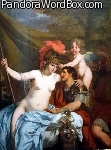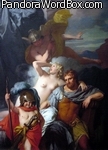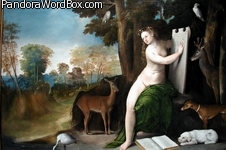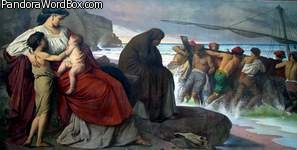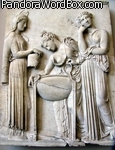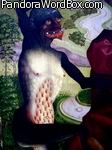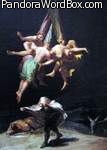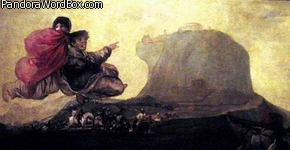WITCHES and BLACK CATS are emblems of Halloween. Implications in WITCH points to WICCA, WICKED, WHIT, WIT and WISDOM which are relevant to better understand why Holloween has such a grasp on celebrants.
In fact, WITCH conveys magic ancient notions that survived millennia and which reverberate in many charming traditions, poetry and literature. Before exploring the past, it is noteworthy to note a "new" "informal" "earth religion" called WICCA. This "movement" was energized by the publications by Mr. Gerald Gardner who, in the 1940's, stimulated beliefs in "Wicca" or "the Craft of the Wise" or WITCHCRAFT. The current penchant for "spiritualism" and "magic" is reflected in bookstores prominently displaying manuals like a "Complete Idiot's Guide to Wiccan Witchcraft" by D. Zimmermann and K. A. Gleason and other publications that claim that this neo-pagan religion has roots in ancient Celtic and Native American beliefs.
The ancient English terms WICCA, WICCE or WIGILA in Frisian emerged from the Latin word uictima for VICTIM. Perhaps it is a poetic coincidence that the etymology of witch underscores the historic fact that they were VICTIMS rather than victimizers, as claimed by religious fanatics.
Charismatic Calypso captivated Odysseus until Zeus ordered her to free him from her charms.
With charm and charisma Circe captured and captivated men.
Before Christianity, ancient witches were portrayed as CHARming CHARismatic CHARacters. Clearly, Circe, Calypso and Medea represent CHARismatic women.
Today, the term WITCH can be used to stigmatize women with superior WIT who have a penchant for rejecting male dominance. The distance from WITCH to WICKED is conceptually quite small. In contrast, males endowed with WIT tend to be called WIZARDS.
Medea had wit and a strong tragic character.
As humanistic values upheld by the Roman civilization were replaced by religious fanaticisms, the social and legal status of women deteriorated. Worse yet, those who had CHARM and CHARISMA became emblems of temptation, and as with Eve, feminine CHARM came to be seen by many as diabolical in nature. In England, Germany and France, at one point, "hunting" for witches became a craze. During this pandemic of mass hysteria, any old woman who was ugly, difficult or vociferous, particularly if she had a wart on the nose, could be declared to be a WITCH. Having an extra nipple (polythelia) was also seen as a work of the Devil. The belief was that extra nipples were for the nourishment of evil spirits. Considering that nearly 10% of people have polythelia, it is remarkable that such insignificant malformations could endanger the survival of babies and cause women to be incinerated. In leading European countries, hundreds of innocent "witches" were burned. Fortunately, more "peripheral" European societies like Italy, Spain or Poland were less infected by this sort of mass hysteria.
Polythelia is an atribute of the Devil.
Contrary to "western" Europe, in Ukraine, a name derived from "okraina" or borderlands, CHARming CHARismatic women are still called CHARivna as if to underscore their "beWITCHing" properties. Women lacking charm but having WIT or VID or VIDomist (vision and knowledge in Ukrainian) can be called VIDMA or witch, but in Ukrainian the term has much less ominous overtones than in English. In fact, the root VIT or VID in Latin, English and Ukrainian, opens broad vistas centered in VISION as in FORESIGHT, "I SEE" or "TO REALIZE" and ultimately to WIT, WISDOM and INTELLIGENCE.
Another vision emerges from the penchant of parents to SCARe and perhaps SCAR the emotions of their children with STRange stories about witches. Again, poetic and etymologic vistas are confluent in that STRehe and STRach in Italian and Ukrainian denote WITCH and FEAR.
From Spanish we get BRUJA for which emerges a pointer to BRUGE, a Belgian city where witch hunts once were as prominent as those in Salem Massachusetts.
Most Brujas do not need a brujula (magnetic needle or compass) to find their way to Brussels nor to Bruge.
Some ancient writers remind us of their times. One unknown author, most likely a male, wrote:
" ... witches have always been uppity women who had to be got rid of ..."
A reverend (John Gaule) tells us how to recognize and condemn a witch:
"... every old woman with ... hairy lip ... squint eye ... scolding tongue ... is not only suspect ... but condemned ..."
Among those who burned witches, were those who justified their actions by citing a Biblical passage (Exodus XXII- 18)
"Thou shalt not suffer a witch to live"
Fortunately, traditions more ancient than Christianity have survived and preserved the CHARM and CHARISMA such as found in BABA YAGA, a ancient Slavic figure of complex femininity. Baba Yaga, witch, wicca, wicked, victim and their extensions toward wit, wise and even IRIS, IRIDESCENT and IRIDIUM are so vast as to require independent overviews.
20181008 ww





